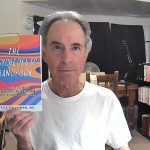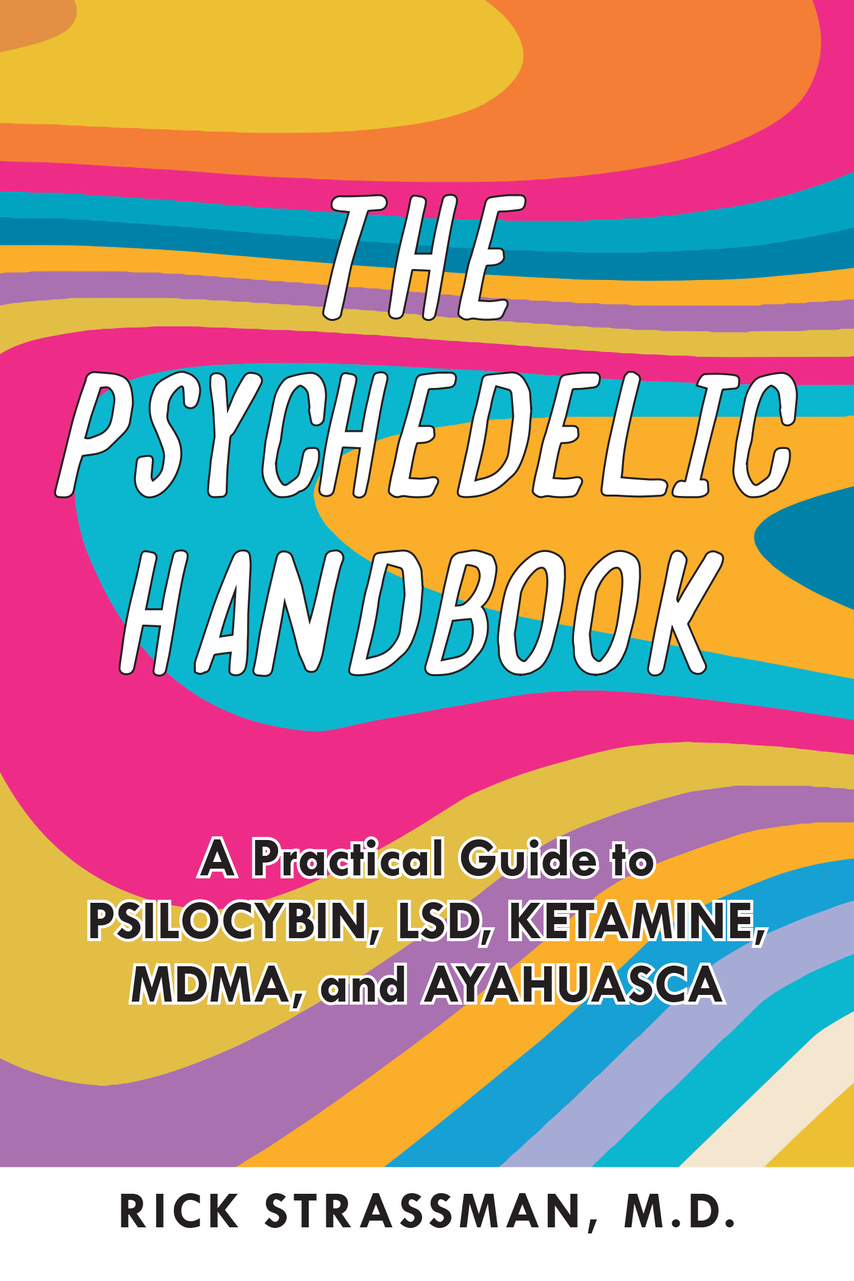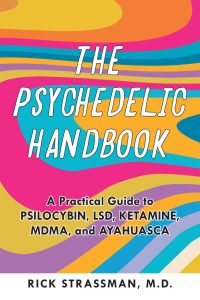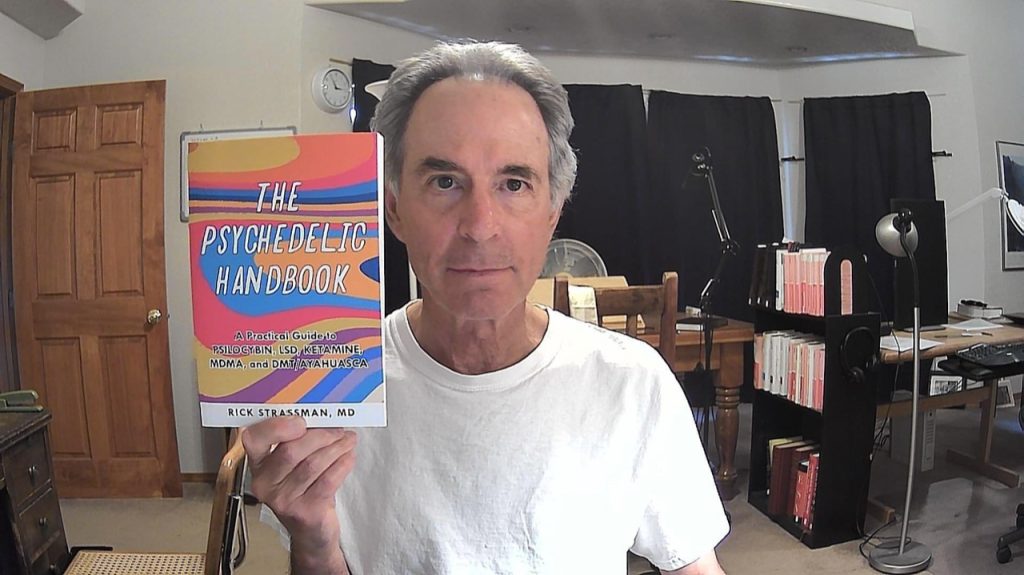Introducing The Psychedelic Handbook: A Practical Guide to Psilocybin, LSD, Ketamine, MDMA, and DMT/Ayahuasca by Rick Strassman, MD, a thoroughly-researched reference book and manual detailing the science and history of psychedelics; the benefits of the drugs, including their potential to treat depression, PTSD, substance abuse, and other disorders, as well as to increase wellness, creativity, and meditation; practical guidelines on how to trip safely and what you should know about microdosing; and recognizing and caring for negative reactions to psychedelics.
Clinical research psychiatrist, founding figure of the American psychedelic research renaissance, and best-selling author of DMT: The Spirit Molecule [2001], Dr. Rick Strassman shares his experience and perspectives as neither advocate nor foe of psychedelics in order to help readers understand the effects of these incredible drugs.
“Psychedelic drugs are remarkable mind-altering substances, arguably the most interesting drugs in all of medicine. They reliably produce a unique state of mind in which you see visions and hear voices. You may lose awareness of your body while your consciousness travels through deep outer—or inner—space. You may feel almost unbearable ecstasy, terror, or both—or nothing at all. No matter what their specific effects might be, the hallmark of any full psychedelic experience is the sense that it is ‘more real than real.’ Effects of some psychedelics begin seconds after smoking or injecting them, and some last up to eighteen hours after consuming them orally.” Dr. Rick Strassman
While neither the author nor publisher Ulysses Press advocates taking drugs nor breaking the law, there are those who are curious enough to venture into this territory to accept the attendant risks. Therefore, it is important to do everything possible to maximize benefits and minimize negative outcomes.
See Rick’s recent appearance on the Joe Rogan Experience here:
https://open.spotify.com/episode/56jFEMXBynPmREm463zRVc
See Graham Hancock’s 2019 Interview with Rick here:
https://www.youtube.com/watch?v=lpT1vVyksWg
Excerpted from The Psychedelic Handbook by Rick Strassman, MD. Copyright © 2022 Ulysses Press. Reprinted with permission from Ulysses Press. New York, NY. All rights reserved.
CHAPTER 11: HOW TO TRIP
Many of us refer to a psychedelic drug experience as a “trip” or “journey.” As with any trip or journey, the more exotic, unfamiliar, and potentially challenging our destination, the more we must do to make sure we are ready. Therefore, I believe it is important to provide guidelines that will help make your experience positive and reduce the risk of a negative outcome.
The three pillars of any psychedelic drug experience are set, setting, and dose. I believe that set—our psychological, physical, and spiritual state, as well as our intention—is the most important leg of this tripod.
Leo Zeff—also known as “the Secret Chief”—was a Bay Area psychologist who died in 1988. Over several decades, he supervised thousands of psychedelic drug experiences. His toolkit included MDMA, LSD, psilocybin, ibogaine, MDA, and ketamine, in addition to eyeshades, comfortable mats, and a wide range of music. I was lucky to have Leo as a mentor in the mid-1980s.
One of Leo’s important insights was that simply deciding to take a psychedelic drug meant that “the trip had already begun.” Our lives have now come under the “influence” of the drug, and we have started thinking about it. What will the trip be like? How should I prepare? What is the best setting? And what will my life be like afterward?
The suggestions that follow relate to full psychedelic doses of these substances. The effects of smaller doses, as I will describe in the next chapter, are not fully psychedelic and usually do not require as much preparation. Nevertheless, if you are uncertain regarding how any dose of a psychedelic will affect you, these procedures for higher-dose experiences are relevant. These instructions will be helpful, too, if you are raising your “microdoses” to more mega ones and want to be prepared if effects are unexpectedly strong.
SHORT-TERM PREPARATION
While the long-term work is that of a lifetime, the suggestions I now present are more psychedelic-specific. They follow your decision to take a trip with one of these substances. They might extend over two to four weeks before your trip, and end only once you have taken the psychedelic drug and the trip itself begins.
I cannot emphasize enough the importance of education. In fact, that is the entire point of this handbook! Some might object to this recommendation and say that studying up on the psychedelic experience will have too much influence on what takes place. This is unreasonable. It is better to be prepared than unprepared. Preparation reduces the risk of being surprised and increases the likelihood that you will recognize, effectively work with, and benefit from what you encounter while tripping.
While everyone’s experience is different, there are broadly similar features that nearly everyone encounters on any particular drug—from 5-methoxy-DMT to ibogaine. Through educating ourselves, we can get a general sense of where we are going: the “geography,” “climate,” even the “inhabitants” and their customs and forms of communication. You do not want to enter such an exotic landscape not knowing what to expect. For example, you should know that a high dose of DMT may cause you to lose awareness of your body—but that does not mean you are dead. Having this foreknowledge will ease your fears when this “loss of the body” takes place. The fully psychedelic experience is often unlike anything else one has ever contended with, and you owe it to yourself to be ready.
Books and other media about these fascinating drugs are more widespread than ever—covering both academic and popular material, as well as first-person accounts. Seek out others who have tripped, listen to talks, join online discussion groups. All will help you to get ready, know better what to expect, navigate your journey successfully, and aid the integration of your trip into daily life.
There also is a vast body of literature on other altered states of consciousness that share features with the psychedelic ones. These include the near death and out-of-body experiences, meditation and prayer, enlightenment and prophecy, and alien abduction. Familiarity with these psychedelic-like states—how others have interpreted and worked with them—can help you approach, understand, and apply what happens to you when you trip.
If you are in therapy and/or have a spiritual teacher, let them know about your decision to take a psychedelic journey. Do not be surprised, however, if they react with disapproval or discouragement. These reactions may occur because your therapist or teacher does not know about psychedelic drugs, has had unpleasant experiences with them, or may have well-thought-out arguments about why psychedelics are not advisable. Whatever the case, they ought to respect your decision, approach it with curiosity and empathy, and discuss things with you openly. If you face unremitting opposition to your decision, you can forgo your trip, find another teacher/therapist, or keep your experiences to yourself. The last option may involve not telling the whole truth, which is less than ideal.
CLARIFYING INTENTION
“Why do I want to take a psychedelic drug?” “What do I hope to gain from my trip?” “What do I wish to avoid?” How we answer these questions is crucial in determining where and with whom we trip, as well as the dose we take. Here are several categories of experiences that most people seek when they take a psychedelic journey.
NEW, UNUSUAL, AND EXCITING EXPERIENCES
Are you curious and seeking novelty? Are you eager to travel through space and time, encounter alternate realities that feel more real than real, even meet their inhabitants? These types of trips require high doses.
PROBLEM-SOLVING
Do you have problems you wish to resolve that you have not been successful resolving in your regular state of consciousness? You may wish to gain new insights about how to deal with creative, professional, psychological, and/or interpersonal obstacles. The mental functions involved in problem-solving are different from those used while traveling through time and space. For this kind of work, you must retain the ability to think, even though your thought processes may take on new power and perspective. You also want to remember the solutions
you come up with. Therefore, lower to mid-range doses will loosen sensory, psychological, and creative chains but still allow you to function.
SPIRITUAL GROWTH
Consider the full range of doses in this case, depending on the nature of the experience you seek. For example, lower doses may aid your understanding of spiritual texts; medium doses may enhance prayer or meditation; and higher doses can potentially propel you into the most exalted realms. While we now frequently hear about the mystical-unitive state, this is not the only type of religious experience possible. Psychedelics may be at least as useful for the interactive-relational type I have discussed previously.
GREED, HATE, AND DELUSION
Not everyone takes psychedelics for noble purposes. These three “great poisons” of Buddhism—beliefs and their resulting actions that lead to our own and others’ suffering—may motivate you, too. Do you have darker intentions? Is there someone or some group you wish to hurt, abuse, or make money from? Do these darker motives take aim at yourself; that is, to replay abusive past or present relationships solely to increase self-pity and confirm your negative self image? For example, are you in an abusive relationship and your intention is to empathize with your violent partner, to “understand” them? Here, the healthier motive might be to resolve to leave this partner, rather than bringing yourself closer to your enemy.
There are likely many reasons to take a psychedelic drug. Not all are conscious, and some may conflict with each other. This means that any experience may be quite different from the one for which you planned. An eagerly anticipated mystical experience may instead become one that deals with career issues. A hoped-for journey through inner/outer space may turn out to be quite down to earth and provide an answer to a health related problem. And of course, the fun trip you wish for may turn out to be painfully difficult.
THE TRIP
No matter how well prepared you are, you must be ready for anything and everything during your journey, especially at higher doses. Since much of your mental world is habitual and unconscious, you may be surprised at what comes up during your trip. Remember, too, that psychedelic experiences are remarkably varied, even within one session. You may enter and exit many different states during a single experience. And there is no guarantee that the same drug at the same dose will produce the same effects from one session to the other.
Hopefully, our preparation—both long- and short-term—has led you to a relatively healthy, positive, and clear-eyed approach to your impending journey. You know what you want and have set things up to direct the outcome accordingly. At the same time, you have worked to minimize anything that would lead to a negative experience.
With shorter-acting drugs, sit or lie comfortably. If seated, make sure you have room to lie down if you begin losing body awareness. For longer-acting substances, you might continue your normal activities for a little while—reading, housework, listening to music—until you feel the first indication that something is happening. Then sit or lie down if you have taken a high dose and observe the development of effects. Even if you have taken a small dose and wish to remain active, be extra careful in your movements and decision-making.
“I am not writing as an advocate or adversary of psychedelic drugs, nor am I a newcomer to the field. Rather, I do not believe that we know enough about what psychedelics do, how they do it, or their positive and negative potential to unequivocally come down on one side or the other. Therefore, my stance is to summarize what we do know, what we do not, and why it matters: scientifically, psychologically, and spiritually.” Dr. Rick Strassman









Thank you for your service to popular culture. This perspective and information, and scientific information about culture to the public, is long overdue.
I have found some amateur forums that discuss the recurrent features encountered in ‘hyperspace’, but without theoretical framework. Do you know of a paper that situates trance experience in the context of the philosophy of archetype, or depth psychology, or structuralist anthropology?
Last year, I wrote three articles about Oracles of the Dead through the ages, at least to scare some casual users, at best to inform the adventurous that there are no shortcuts to maturity and psychological self-actualisation. Here is a link to one of the three articles: https://stoneprintjournal.wordpress.com/2019/10/09/ayahuasca-oracle-of-the-dead-is-a-counter-cult-to-divide-and-kill-culture-part-i/
Hi, very informative as to the types of drugs. I have PTSD due t0 Vietnam and I also have prostate cancer.
What might be the right way to start?